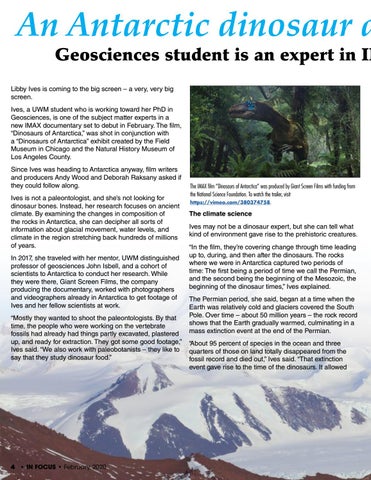An Antarctic dinosaur d
Geosciences student is an expert in IM
Libby Ives is coming to the big screen – a very, very big screen. Ives, a UWM student who is working toward her PhD in Geosciences, is one of the subject matter experts in a new IMAX documentary set to debut in February. The film, “Dinosaurs of Antarctica,” was shot in conjunction with a “Dinosaurs of Antarctica” exhibit created by the Field Museum in Chicago and the Natural History Museum of Los Angeles County. Since Ives was heading to Antarctica anyway, film writers and producers Andy Wood and Deborah Raksany asked if they could follow along. Ives is not a paleontologist, and she’s not looking for dinosaur bones. Instead, her research focuses on ancient climate. By examining the changes in composition of the rocks in Antarctica, she can decipher all sorts of information about glacial movement, water levels, and climate in the region stretching back hundreds of millions of years. In 2017, she traveled with her mentor, UWM distinguished professor of geosciences John Isbell, and a cohort of scientists to Antarctica to conduct her research. While they were there, Giant Screen Films, the company producing the documentary, worked with photographers and videographers already in Antarctica to get footage of Ives and her fellow scientists at work. “Mostly they wanted to shoot the paleontologists. By that time, the people who were working on the vertebrate fossils had already had things partly excavated, plastered up, and ready for extraction. They got some good footage,” Ives said. “We also work with paleobotanists – they like to say that they study dinosaur food.”
4 • IN FOCUS • February, 2020
The IMAX film “Dinosaurs of Antarctica” was produced by Giant Screen Films with funding from the National Science Foundation. To watch the trailer, visit https://vimeo.com/380374758.
The climate science Ives may not be a dinosaur expert, but she can tell what kind of environment gave rise to the prehistoric creatures. “In the film, they’re covering change through time leading up to, during, and then after the dinosaurs. The rocks where we were in Antarctica captured two periods of time: The first being a period of time we call the Permian, and the second being the beginning of the Mesozoic, the beginning of the dinosaur times,” Ives explained. The Permian period, she said, began at a time when the Earth was relatively cold and glaciers covered the South Pole. Over time – about 50 million years – the rock record shows that the Earth gradually warmed, culminating in a mass extinction event at the end of the Permian. “About 95 percent of species in the ocean and three quarters of those on land totally disappeared from the fossil record and died out,” Ives said. “That extinction event gave rise to the time of the dinosaurs. It allowed





